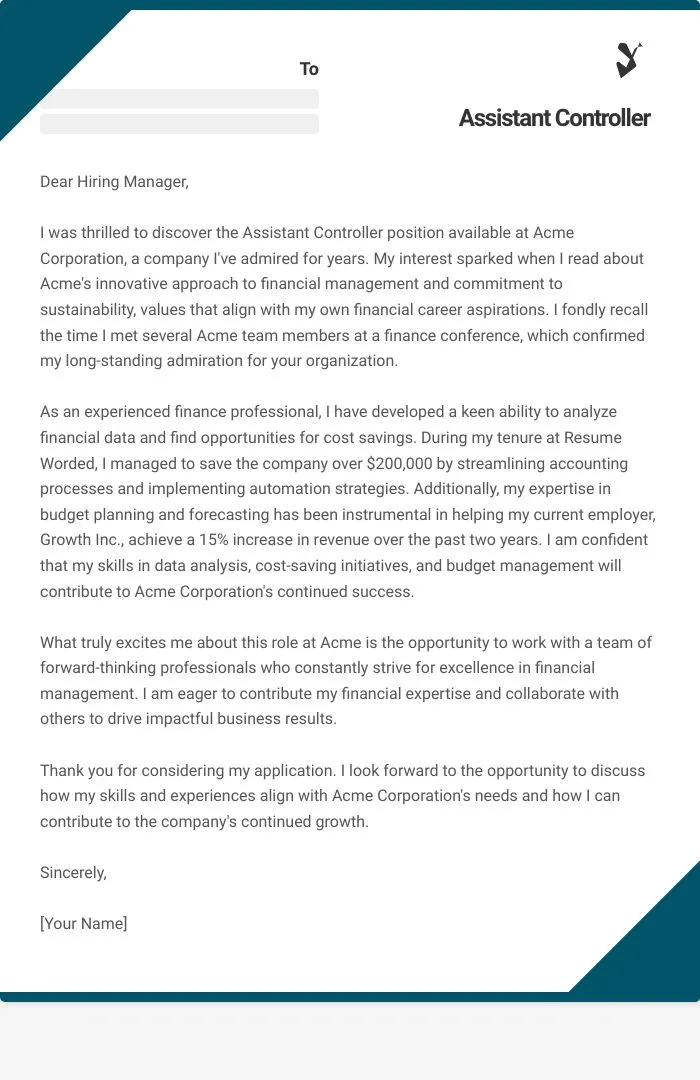What Is a Controller Cover Letter
A controller cover letter is a crucial document accompanying your resume when applying for controller positions. It serves as your introduction to a potential employer, providing an opportunity to highlight your skills, experience, and qualifications in a tailored manner. Unlike a resume, which provides a factual overview of your career, a cover letter allows you to articulate your passion, explain your career goals, and demonstrate how your expertise aligns with the specific needs of the company and the job description. The primary objective is to persuade the hiring manager that you are the best candidate for the role. It’s not just a formality it’s a strategic tool for securing an interview.
Why Is a Cover Letter Important for Controller Roles
For controller positions, a cover letter holds significant importance because it provides a platform to showcase the qualities that go beyond the technical requirements of the job. Controllership involves more than just crunching numbers; it requires leadership, strategic thinking, and the ability to communicate complex financial information effectively. A well-crafted cover letter enables you to express your understanding of these broader responsibilities and demonstrate your ability to contribute to the company’s financial health and strategic goals. It allows you to differentiate yourself from other candidates by highlighting your unique experiences, accomplishments, and your understanding of the company’s mission and values. Therefore, it offers a critical advantage in a competitive job market.
Essential Components of a Controller Cover Letter
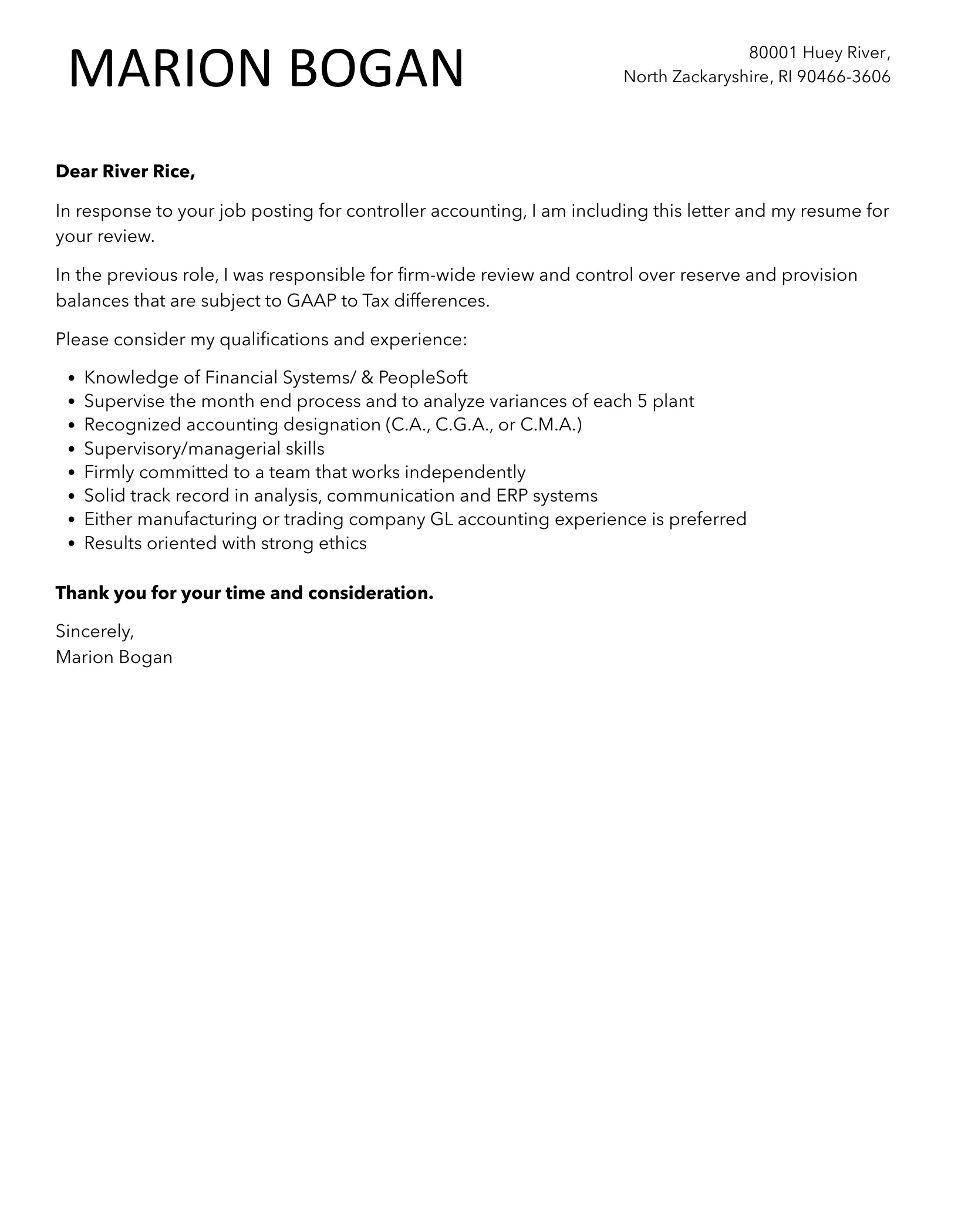
A compelling controller cover letter incorporates several key components. These elements, when combined, create a persuasive argument for why you are the ideal candidate. Focusing on the fundamentals ensures that your letter is clear, concise, and impactful. Each section should work in harmony to convey your qualifications, experience, and suitability for the role, making your application stand out.
Header and Contact Information
Begin with a professional header that includes your full name, address, phone number, and email address. It’s essential to ensure that your contact information is accurate and up-to-date. Consider adding a link to your LinkedIn profile or professional website, if applicable. Position the header at the top of the document, ensuring that it is easily readable and well-organized. This section is critical as it allows recruiters to easily reach you if they are interested in your candidacy. (Image: controller-cover-letter-header.webp)
Professional Greeting
Address the hiring manager by name if possible. Researching the name of the hiring manager through the company’s website or LinkedIn shows initiative and personalization. If you cannot find a specific name, using a general greeting like “Dear Hiring Manager” is acceptable, but try to find a more personal touch to grab the reader’s attention. Avoid generic greetings such as “To Whom It May Concern,” which can give the impression of a mass-produced application. The greeting sets the tone for the entire letter, so make sure it’s professional and engaging.
Opening Paragraph Hooking the Reader
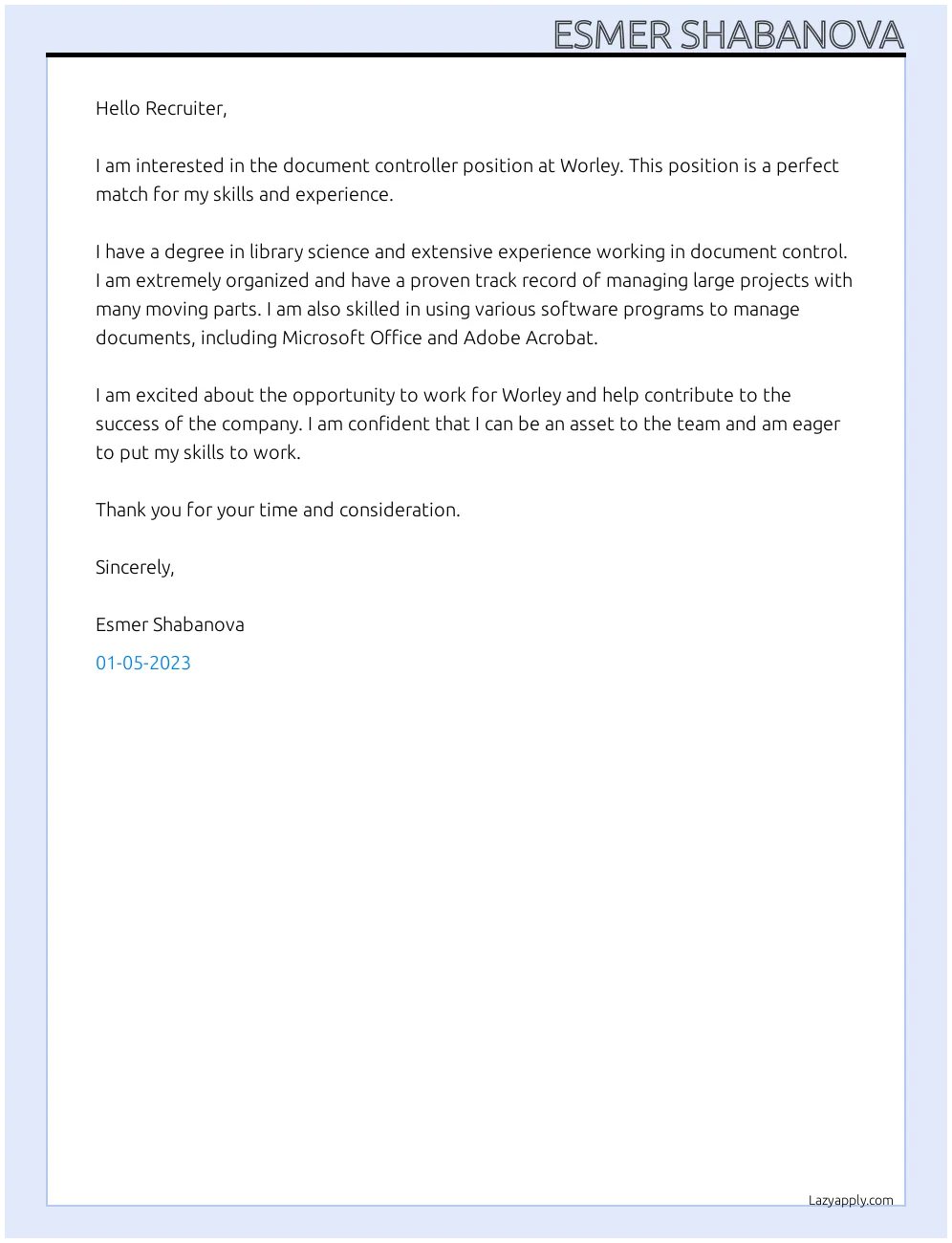
The opening paragraph should immediately capture the reader’s attention. Begin with a compelling statement that reflects your enthusiasm for the role and the company. Mention the specific position you are applying for and how you learned about it. Briefly summarize your key qualifications and experience, emphasizing what makes you an ideal candidate. This initial paragraph should create a strong first impression, encouraging the hiring manager to continue reading. Use a hook that is both concise and focused on the company’s needs and your value proposition.
Highlighting Your Skills and Experience
This section forms the core of your cover letter. Here, you elaborate on your relevant skills and experience in detail. Focus on the experiences and skills that directly align with the job description. Provide specific examples of your accomplishments and responsibilities in previous roles. Use action verbs to describe your contributions and quantify your achievements whenever possible. Showcase your understanding of accounting principles, financial reporting, budgeting, forecasting, and any relevant industry-specific knowledge. (Image: controller-cover-letter-skills.webp)
Quantifying Achievements and Results
Quantifying your achievements is a critical aspect of making your cover letter stand out. Rather than simply stating your responsibilities, use numbers and data to demonstrate your impact. For example, instead of saying “Managed the budgeting process,” state “Led the budgeting process, resulting in a 15% reduction in operational costs.” Include specific metrics such as cost savings, revenue increases, process improvements, or efficiency gains. This evidence provides tangible proof of your capabilities and helps the hiring manager quickly understand your value. (Image: controller-cover-letter-quantify.webp)
Demonstrating Knowledge of Accounting Principles
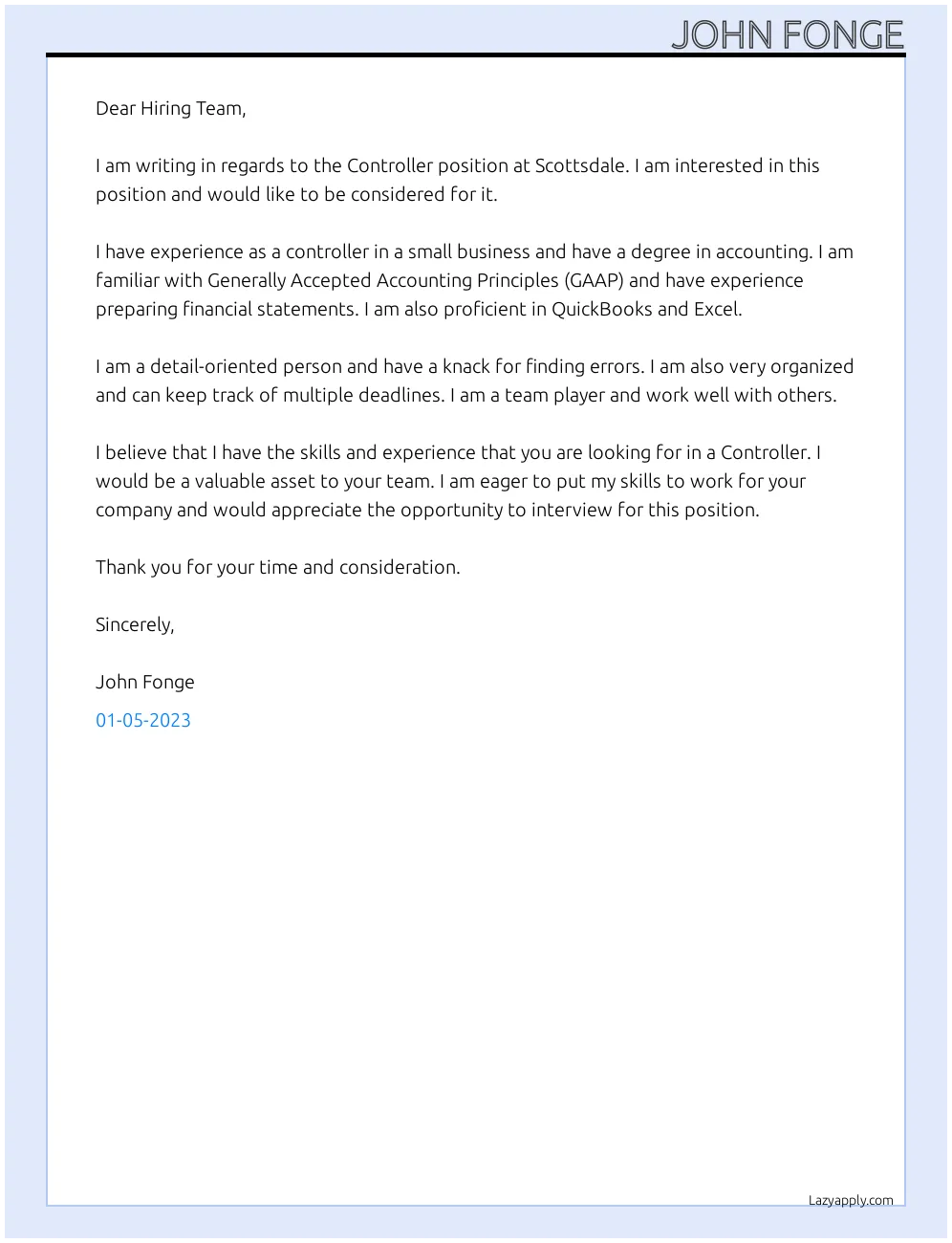
Controller roles require a solid understanding of accounting principles and practices. Clearly demonstrate your knowledge of GAAP (Generally Accepted Accounting Principles), IFRS (International Financial Reporting Standards), and other relevant accounting standards. Mention your experience with financial statements, audits, internal controls, and tax regulations. If you hold any professional certifications, such as a CPA (Certified Public Accountant), prominently display them. Showcasing your technical expertise reassures the hiring manager of your ability to perform the core functions of the role.
Showcasing Leadership and Management Abilities
Controller positions often involve managing a team of accounting professionals. In your cover letter, highlight your leadership and management abilities. Provide examples of your experience in leading and motivating teams, developing and implementing training programs, and fostering a positive work environment. Describe any achievements related to team performance, such as increased productivity, improved accuracy, or reduced employee turnover. Emphasizing your leadership capabilities is crucial to demonstrate your ability to oversee and manage the accounting department effectively. (Image: controller-cover-letter-leadership.webp)
Tailoring Your Cover Letter to the Job Description
A generic cover letter is unlikely to impress a hiring manager. Tailor your cover letter to each job application. Carefully review the job description, identifying the key requirements and desired skills. Highlight how your experience and qualifications align with these specific needs. Use the same language and keywords that are used in the job description. By demonstrating that you have carefully considered the position and are a strong fit for the role, you increase your chances of getting an interview. The goal is to show that you have a deep understanding of what the role requires.
Researching the Company and the Role
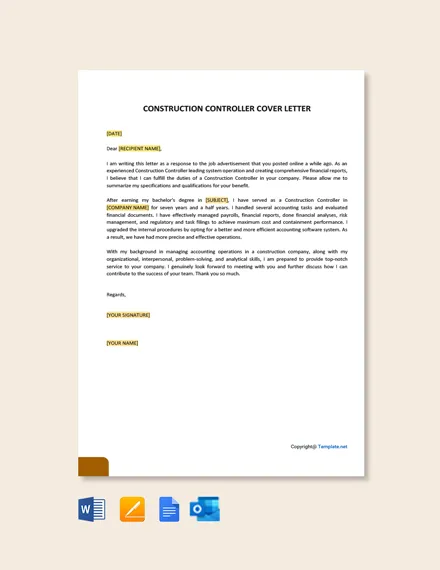
Before you start writing, research the company and the specific role. Visit the company’s website to learn about its mission, values, and recent achievements. Review the job description carefully to understand the responsibilities and qualifications required. Identify any specific challenges the company may be facing and consider how your skills and experience can address them. Demonstrating knowledge of the company’s operations and industry shows your genuine interest and commitment, and enables you to tailor your cover letter to highlight your relevant experience.
Matching Skills and Experience to Requirements
Create a clear and concise mapping of your skills and experience to the job’s requirements. Go through the job description and identify the key skills and qualifications that the employer is seeking. Then, for each requirement, provide specific examples from your past experiences that demonstrate your ability to meet those requirements. This approach allows the hiring manager to quickly see that you possess the necessary qualifications, and how your experiences align with the specific needs of the role. This demonstrates your suitability for the position.
Including Relevant Keywords
Use relevant keywords throughout your cover letter. Keywords are the words and phrases that describe the skills, experience, and qualifications sought by the employer. Refer to the job description and identify the key terms used to describe the role. Incorporate these keywords naturally into your writing, especially in the skills and experience section. This helps your application pass through applicant tracking systems (ATS) and makes your cover letter more relevant to the hiring manager. (Image: controller-cover-letter-keywords.webp)
Formatting and Design Best Practices
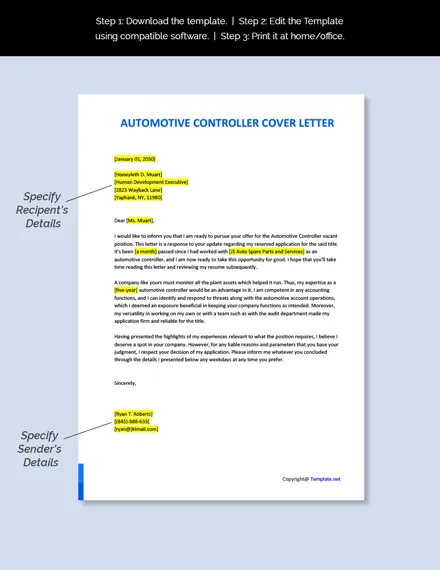
The formatting and design of your cover letter can significantly impact its readability and professional appearance. Adhering to best practices ensures that your cover letter is easy to read and visually appealing, making a positive first impression. Pay attention to the elements of design to create a well-organized and professional document.
Choosing the Right Font and Font Size
Choose a professional and easily readable font. Common fonts such as Times New Roman, Arial, Calibri, or Georgia are good choices. Keep the font size between 10 and 12 points. Ensure that the font size is consistent throughout the document. A well-chosen font and size improve readability, helping the hiring manager to focus on your qualifications rather than struggling to read your document.
Using Clear and Concise Language
Use clear, concise, and professional language. Avoid jargon, technical terms, and overly complex sentences. Keep your sentences and paragraphs short and to the point. Use active voice instead of passive voice whenever possible. Use bullet points and numbered lists to organize information, making it easier to read and digest. Focus on conveying your message directly and efficiently.
Proofreading and Editing Your Cover Letter
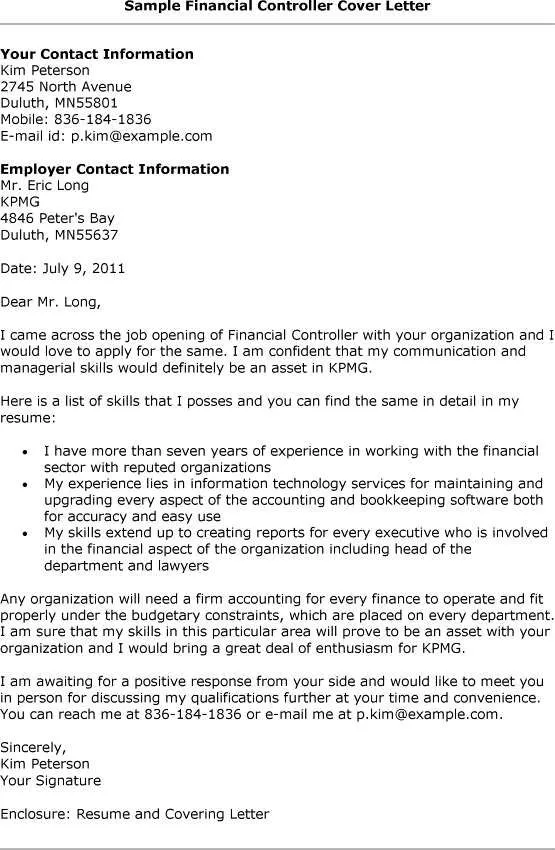
Proofreading and editing your cover letter is a crucial step in ensuring that it is polished and professional. Carefully check for any grammatical errors, spelling mistakes, and typos. Make sure your punctuation is correct and that the formatting is consistent. Consider asking a friend or colleague to review your cover letter for accuracy and clarity. A well-proofread cover letter demonstrates attention to detail and professionalism. The details matter.
Common Mistakes to Avoid
Avoiding common mistakes can significantly improve the effectiveness of your cover letter. These errors can detract from your qualifications and create a negative impression. By being aware of these pitfalls, you can avoid them and ensure that your cover letter is a strong representation of your abilities.
Generic Statements and Lack of Specificity
Avoid using generic statements that could apply to any job. Instead, provide specific examples and details that demonstrate your skills and experience. Don’t say “I am a team player;” instead, describe your experience in team projects and the role you played. Quantify your achievements whenever possible. Make your cover letter unique and tailored to the specific role you are applying for. General statements show a lack of preparation and attention to detail, and do not capture the reader’s attention.
Typos and Grammatical Errors
Typos and grammatical errors can instantly undermine your credibility. Thoroughly proofread your cover letter before submitting it. Use grammar-checking tools and consider having a friend or colleague review your work. Errors can make you look unprofessional and diminish your chances of getting an interview. Always make sure you take the time to thoroughly review your work, proofreading and editing is critical for attention to detail. (Image: controller-cover-letter-mistakes.webp)
Lengthy and Overly Detailed Content
Keep your cover letter concise and to the point. Avoid providing excessive detail or repeating information that is already in your resume. Aim for a length of one page. Make sure every sentence contributes to the overall message. Lengthy cover letters may discourage the reader, while clear and concise writing allows you to convey the most important information effectively.
Examples of Effective Controller Cover Letters
Reviewing successful controller cover letter examples can provide valuable insights. These examples can inspire you and help you create your own effective cover letter. Analyze what works and consider incorporating those elements into your application. (Image: controller-cover-letter-example.webp)
Example 1 Controller with Extensive Experience
A successful cover letter from a controller with extensive experience typically emphasizes the candidate’s long-term career trajectory and proven results. It would highlight the candidate’s tenure in the field, showcasing their consistency and commitment. It should also highlight successful project management experience and quantify any contributions such as cost reductions. It would also demonstrate the candidates’ ability to manage accounting teams and implement changes that result in financial improvements. A strong example would provide very specific examples of achievements and provide data to support their claims.
Example 2 Controller with a Focus on Leadership
A cover letter from a controller emphasizing leadership abilities would focus on experiences managing and developing teams. The candidate would provide examples of how they motivated and guided their teams to achieve financial objectives. The candidate would showcase their ability to create and maintain a positive work environment. Examples would include specific instances of improved team performance and implementation of successful training programs. This would be a strong example of a cover letter highlighting the management experience of the candidate.
Example 3 Controller with a Strong Financial Background
A cover letter emphasizing a strong financial background would highlight expertise in areas such as financial reporting, budgeting, and forecasting. The candidate would showcase experiences with financial statement analysis, audit, and compliance. Including details of experience with financial modeling, variance analysis, and capital projects would be a strong advantage for the candidate. Also include experiences working with different accounting software or implementation projects. The candidate should be able to showcase their ability to contribute to the organization’s financial goals.
Final Thoughts and Next Steps
Crafting a compelling cover letter requires careful planning and attention to detail. By following these guidelines, you can create a cover letter that effectively showcases your qualifications and increases your chances of securing an interview. Remember to tailor your cover letter to each specific job application and always proofread it carefully. A well-written cover letter is essential for a successful job search. It represents your best self and should reflect your understanding of the role and the company’s needs. The key is to present your skills and experience clearly, concisely, and persuasively.
Tips for Following Up After Submitting Your Application
After submitting your application, follow up with the hiring manager to express your continued interest. You can send a brief email a week or two after submitting your application, reiterating your interest and highlighting your key qualifications. Make sure the tone is professional and respectful. Following up shows your enthusiasm and initiative. A well-timed follow-up can help you stay top-of-mind and increase your chances of getting an interview.
